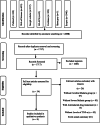Association of cerebral malaria and TNF-α levels: a systematic review
- PMID: 32576141
- PMCID: PMC7310527
- DOI: 10.1186/s12879-020-05107-2
Association of cerebral malaria and TNF-α levels: a systematic review
Abstract
Background: Cerebral malaria is the most severe form of infection with Plasmodium falciparum characterized by a highly inflammatory response. This systematic review aimed to investigate the association between TNF-α levels and cerebral malaria.
Methods: This review followed the Preferred Reporting of Systematic Review and Meta-analyses (PRISMA) guidelines. The search was performed at PubMed, LILACS, Scopus, Web of Science, The Cochrane Library, OpenGrey and Google Scholar. We have included studies of P. falciparum-infected humans with or without cerebral malaria and TNF-α dosage level. All studies were evaluated using a risk of bias tool and the GRADE approach.
Results: Our results have identified 2338 studies, and 8 articles were eligible according to this systematic review inclusion criteria. Among the eight articles, five have evaluated TNF- α plasma dosage, while two have evaluated at the blood and one at the brain (post-Morten). Among them, only five studies showed higher TNF-α levels in the cerebral malaria group compared to the severe malaria group. Methodological problems were identified regarding sample size, randomization and blindness, but no risk of bias was detected.
Conclusion: Although the results suggested that that TNF-α level is associated with cerebral malaria, the evidence is inconsistent and imprecise. More observational studies evaluating the average TNF-alpha are needed.
Keywords: Cerebral malaria; Malaria; P. falciparum; Systematic review; TNF-α.
Conflict of interest statement
The authors declare that they have no competing interests.
Figures
Similar articles
-
Severe malaria in Cameroonian children: correlation between plasma levels of three soluble inducible adhesion molecules and TNF-alpha.Acta Trop. 2007 Apr;102(1):20-8. doi: 10.1016/j.actatropica.2007.02.011. Epub 2007 Feb 27. Acta Trop. 2007. PMID: 17397790
-
Association of high plasma TNF-alpha levels and TNF-alpha/IL-10 ratios with TNF2 allele in severe P. falciparum malaria patients in Sri Lanka.Pathog Glob Health. 2013 Jan;107(1):21-9. doi: 10.1179/2047773212Y.0000000069. Pathog Glob Health. 2013. PMID: 23432860 Free PMC article.
-
Plasmodium falciparum and TNF-α Differentially Regulate Inflammatory and Barrier Integrity Pathways in Human Brain Endothelial Cells.mBio. 2022 Oct 26;13(5):e0174622. doi: 10.1128/mbio.01746-22. Epub 2022 Aug 29. mBio. 2022. PMID: 36036514 Free PMC article.
-
Artemether for severe malaria.Cochrane Database Syst Rev. 2019 Jun 18;6(6):CD010678. doi: 10.1002/14651858.CD010678.pub3. Cochrane Database Syst Rev. 2019. PMID: 31210357 Free PMC article.
-
Cytokine levels in the severity of falciparum malaria: An umbrella review.Acta Trop. 2024 Dec;260:107447. doi: 10.1016/j.actatropica.2024.107447. Epub 2024 Oct 28. Acta Trop. 2024. PMID: 39477046 Review.
Cited by
-
Eosinophils Suppress the Migration of T Cells Into the Brain of Plasmodium berghei-Infected Ifnar1-/- Mice and Protect Them From Experimental Cerebral Malaria.Front Immunol. 2021 Sep 30;12:711876. doi: 10.3389/fimmu.2021.711876. eCollection 2021. Front Immunol. 2021. PMID: 34659202 Free PMC article.
-
Pathogenicity and virulence of malaria: Sticky problems and tricky solutions.Virulence. 2023 Dec;14(1):2150456. doi: 10.1080/21505594.2022.2150456. Virulence. 2023. PMID: 36419237 Free PMC article. Review.
-
Malaria-induced bacteremia as a consequence of multiple parasite survival strategies.Curr Res Microb Sci. 2021 May 8;2:100036. doi: 10.1016/j.crmicr.2021.100036. eCollection 2021 Dec. Curr Res Microb Sci. 2021. PMID: 34841327 Free PMC article. Review.
-
CircDCLRE1C Regulated Lipopolysaccharide-Induced Inflammatory Response and Apoptosis by Regulating miR-214b-3p/STAT3 Pathway in Macrophages.Int J Mol Sci. 2022 Jun 19;23(12):6822. doi: 10.3390/ijms23126822. Int J Mol Sci. 2022. PMID: 35743265 Free PMC article.
-
Circulating biomarkers associated with pediatric sickle cell disease.Front Mol Biosci. 2024 Dec 19;11:1481441. doi: 10.3389/fmolb.2024.1481441. eCollection 2024. Front Mol Biosci. 2024. PMID: 39749215 Free PMC article.
References
Publication types
MeSH terms
Substances
LinkOut - more resources
Full Text Sources


